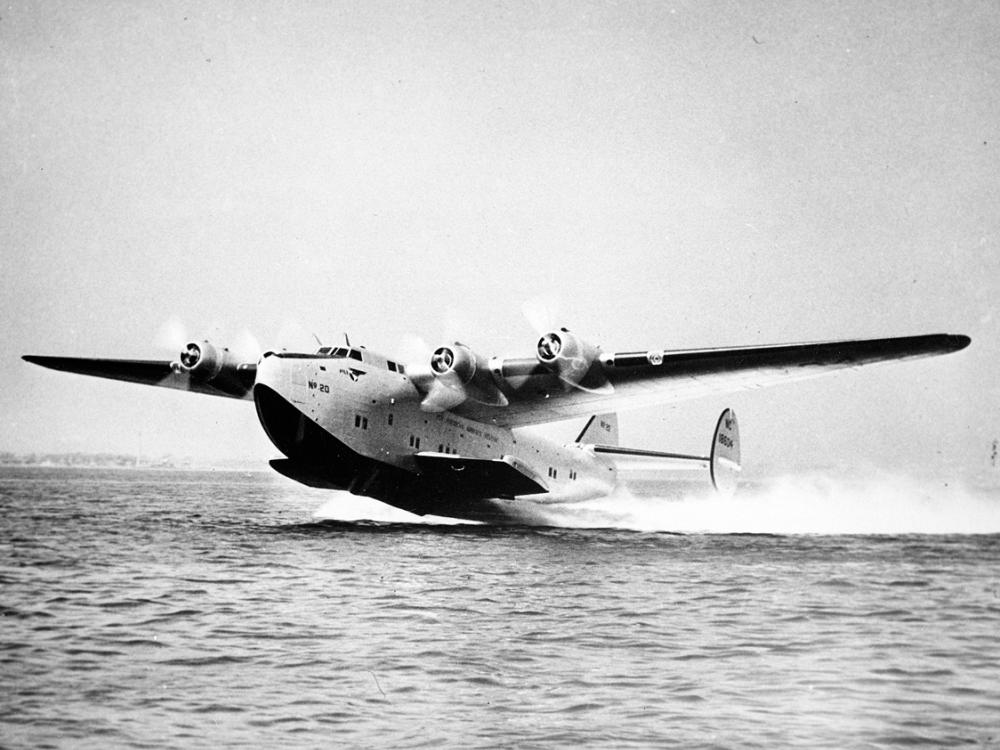



Dec 08, 2011
By Robert van der Linden is Chair of the Aeronautics Division at the National Air and Space Museum.
Pan Am Boeing 314.
Stranded. Six days from its home port of San Francisco, a luxurious Boeing 314 flying boat, the Pacific Clipper, was preparing to alight in Auckland, New Zealand, as part of the airline’s transpacific service when the crew of ten learned of the Japanese attack on the U.S. fleet at Pearl Harbor on the morning of December 7, 1941. All across the Pacific, Pan Am facilities came under assault: Wake Island, where the Martin M-130 Philippine Clipper returned just in time to pick up the Pan Am staff and escape although riddled with bullet holes; Manila, which had come under direct air attack; Hong Kong, where a Sikorsky S-42B was destroyed at its dock; and, of course, Pearl Harbor. Where to go?
Pan Am Captain Robert Ford was faced with a dilemma. After a week in the U.S. Embassy Ford finally received word from Pan Am headquarters that they were to return to the U.S. by flying westward. They were on their own for gasoline and supplies and had to fly over land and water with which none of the crew was familiar. With orders in hand, Captain Ford took off on December 16th, unsure of his fate, backtracked to Noumea, New Caledonia, to pick up the Pan Am staff left there and headed west for Australia. Hours later, they put down in Gladstone, north of Brisbane on the Coral Sea. The next day, Captain Ford and the Pacific Clipper headed northwest to Darwin, flying over the Queensland desert and watching it gradually transform into tropical rainforest near their destination of Darwin. The next goal was Surabaya, in the Dutch East Indies (present day Indonesia). Keeping their fingers crossed that the Japanese expansion had not reached this far, the crew of the massive flying boat flew 2,253 kilometers (1,400 miles) over open ocean and reached the city but not before they were intercepted by suspicious British fighter aircraft and escorted in to safety after taxiing through mined waters.
After refueling with automobile grade gasoline, since no 100 octane fuel was available, the Pacific Clipper carefully took off and headed for Trincomalee, Ceylon (now Sri Lanka) without any charts, only the coordinates of their destination. With remarkable precision, navigator Roderick Brown found the island and the port city where they alighted safely, although only after avoiding a patrolling Japanese submarine. Refueling once again, the Boeing 314 left Trincomalee on Christmas Eve only to turn back after losing an engine. Repairs took all day on Christmas before they retook to the air on Boxing Day bound for Karachi, India (now Pakistan). After an uneventful flight, Captain Ford continued safely on to Bahrain and then across the vast desert expanse of the Arabian peninsula to Khartoum, Sudan, where they alighted on the Nile. Not wishing to risk any further desert flying, the crew of the Pacific Clipper pressed on to Leopoldville in the Belgian Congo (now Kinshasa in the Democratic Republic of the Congo) and was able to put the huge flying boat down on the Congo River when they reached their destination.
To avoid flying across the Pacific after the attack on Pearl Harbor, the Pacific Clipper flew westward, three-fourths of the way around the world, to New York.
Fighting the oppressive heat and the strong current of the river, the flying boat once again clawed into the sky becoming airborne before reaching a set of waterfalls. Safely clear of the obstacles, the Pacific Clipper droned 5,766 kilometers (3,583 miles) westward to Natal, Brazil, then up the coast to Port of Spain, Trinidad, and finally on January 6, 1942, to the Marine terminal at La Guardia, Long Island, New York. Total flight time was 209 hours which covered 50,694 kilometers (31,500 miles). It was the first around the world flight by a commercial airliner — the hard way.
After this historic flight, the Pacific Clipper was assigned to the U.S. Navy for the rest of World War II. When the War ended, the aircraft was sold to Universal Airlines who salvaged it after it was damaged in a storm.
Have you ever had a harrowing flight experience? Tell us about it.




We rely on the generous support of donors, sponsors, members, and other benefactors to share the history and impact of aviation and spaceflight, educate the public, and inspire future generations. With your help, we can continue to preserve and safeguard the world’s most comprehensive collection of artifacts representing the great achievements of flight and space exploration.
We rely on the generous support of donors, sponsors, members, and other benefactors to share the history and impact of aviation and spaceflight, educate the public, and inspire future generations. With your help, we can continue to preserve and safeguard the world’s most comprehensive collection of artifacts representing the great achievements of flight and space exploration.